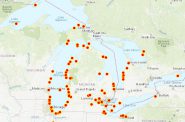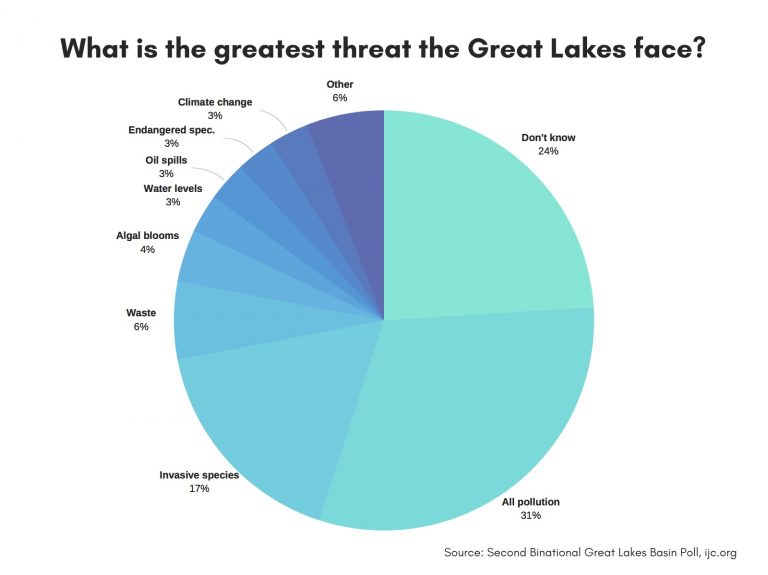Climate Change Linked to Invasive Species
Polls show residents more concerned about invasive species, but climate change helps invaders thrive.
Great Lakes residents are more concerned about invasive species than climate change, according to a recent poll.
But researchers say that the two are closely linked.
“Climate change is just one more disturbance that helps invasive species to rise,” said Carrie Brown-Lima, director of the New York Invasive Species Research Institute at Cornell University.
“Invasive species are the first to adapt to warmer climate, but native species don’t have that advantage,” Brown-Lima said.
An invasive species is one transported by people and that causes ecological and economic damage.
![Ruffe, is an invasive species in the Great Lakes. Photo by Tiit Hunt [CC BY-SA 3.0 (https://creativecommons.org/licenses/by-sa/3.0)], from Wikimedia Commons](https://urbanmilwaukee.com/wp-content/uploads/2018/10/1024px-Gymnocephalus_cernuus_Pärnu_River_Estonia_2010-01-06-590x393.jpg)
Ruffe, is an invasive species in the Great Lakes. Photo by Tiit Hunt [CC BY-SA 3.0 (https://creativecommons.org/licenses/by-sa/3.0)], from Wikimedia Commons
Those polled ranked invasive species only below pollution in a list of concerns about the Great Lakes water quality and surrounding environment. Seventeen percent said invasive species was of highest concern. Only 3 percent listed climate change as one of their top worries.
In warmer water, certain invasive fish have a higher metabolism which helps them compete against native fish, Brown-Lima said. They eat native food and the natives themselves. The process could eliminate species that were once native to the region.
Invasive plant species in the Great Lakes are much more resilient than native species which makes them far more likely to thrive and disrupt ecosystems, she said.
Increasing water temperatures in the lakes leads to shorter periods of ice, allowing for the invasive aquatic species to thrive, Brown-Lima said. The annual ice coverage of the Great Lakes decreased 71 percent between 1973 and 2010, according to the Great Lakes Integrated Sciences and Assessments, a team from the National Oceanic and Atmospheric Administration that focuses on adapting to climate change.
The poll also found
- Most respondents (88 percent) think protecting the Great Lakes is crucial.
- About 95 percent of the 300 Indigenous respondents said there were too few regulations protecting the Great Lakes; 50 percent of non-Indigenous respondents said there were too few regulations.
- The biggest environmental concern that 30 percent of respondents listed is pollution to the lakes.
- Millennials 18-34 years old and those with liberal political views are more likely to support policy to protect the Great Lakes than conservatives or other age groups.
This story was originally published by Great Lakes Echo.
Eyes on Milwaukee
-
Church, Cupid Partner On Affordable Housing
 Dec 4th, 2023 by Jeramey Jannene
Dec 4th, 2023 by Jeramey Jannene
-
Downtown Building Sells For Nearly Twice Its Assessed Value
 Nov 12th, 2023 by Jeramey Jannene
Nov 12th, 2023 by Jeramey Jannene
-
Immigration Office Moving To 310W Building
 Oct 25th, 2023 by Jeramey Jannene
Oct 25th, 2023 by Jeramey Jannene
Great Lakes Echo
-
Tracking Balloon Debris in Great Lakes
 Dec 3rd, 2019 by Tasia Bass Cont
Dec 3rd, 2019 by Tasia Bass Cont
-
Coal Ash Pollutes Midwest States
 Jun 5th, 2019 by Andrew Blok
Jun 5th, 2019 by Andrew Blok
-
Extreme Changes Forecast for Great Lakes
 May 21st, 2019 by Cassidy Hough
May 21st, 2019 by Cassidy Hough
















